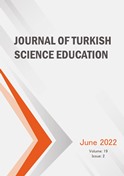Moroccan university students’ conceptions of neurotransmission
DOI:
https://doi.org/10.36681/Keywords:
Conception, nervous message, neurotransmitter, neurotransmission, synapseAbstract
Neurotransmission represents a key concept in the history of biology. The objective of this study is to elicit Moroccan university students‟ conceptions of neurotransmission and highlight potential difficulties and obstacles that may hinder its effective learning. A questionnaire was administered to 120 science students as a pre-test. After the neurotransmission course at Dhar El Mahraz Faculty of Science, the same questionnaire was re-administered. The results of the study appeared that the majority of the science students had deficiencies at integrating and assimilating the concept of neurotransmission and other related concepts.
Downloads
References
Abraham, J. K., Perez, K. E., & Price, R. M. (2014). The dominance concept inventory: a tool for assessing undergraduate student alternative conceptions about dominance in Mendelian and population genetics. CBE-Life Sciences Education, 13(2), 349-358. doi: 10.1187/cbe.13-08-0160.
Albanese, A., & Vicentini, M. (1997). Why do you believe that an atom is colourless? Reflections about the teaching of the particle model. Science and Education, 6(3), 251261.
Astolfi, J. P., & Develay, M. (1989). La didactique des sciences. Paris, France: Presses Universitaires de France.
Astolfi, J.P. (1992). Apprendre par franchissement d'obstacles? Repères, Recherches en Didactique du Français Langue Maternelle, 5, 103–116.
Astolfi, J. P., & Peterfalvi, B. (1993). Obstacles et construction de situations didactiques en sciences expérimentales. Aster, 16(1), 103-142.
Bec, J. L., & Favre, D. (1996). Le système nerveux dans le programme de Biologie: Quel(s) concept(s) veut-on enseigner? Tréma. Les spécificités de la biologie et de son enseignement, (9-10), 97-104.
Clarac, F., & Ternaux, J. P. (2008). Encyclopedie historique des neurosciences. Du Neurone à L'émergence de la Pensée. Bruxelles, Belgique : De Boeck Supérieur.
Clément. P. (1994). Difficile évolution des conceptions sur les rapports entre cerveau, idées et âme. In A. Giordan, Y. Girault & P. Clément (Eds.), Conceptions et connaissances (pp.73-91).
Berne, Switzerland: Peter Lang. Clément, P. (1994). Représentations, conceptions, connaissances. In A.Giordan, P. Girault & P. Clément (Eds.), Conceptions et connaissances.Berne, Switzerland: Peter Lang.
Darley, B. (1994). L’enseignement de la démarche scientifique dans les travaux pratiques de biologie à l’université. Analyses et propositions. (Unpublished doctoral dissertation).Université de Grenoble 1, France.
Debru, C. (1999). Préface in J. C. Dupont (Ed.), Histoire de la neurotransmission (pp. 1-7). Paris, France: Presses Universitaires de France.
Di Sessa, A. (2002). Why “conceptual ecology” is a good idea. In M. Limon & L. Mason (Eds.), Reconsidering conceptual change: Issues in theory and practice (pp.28-60). Dordrecht, The Netherlands: Springer.
Dupont, J. C. (1999). Histoire de la neurotransmission. Paris, France : Presses Universitaires de France.
Giordan, A., & Martinand, J. L. (1988). Etat des recherches sur les conceptions des apprenants à propos de la Biologie. Annales de la Didactique des Sciences, 2,11-63.
Gonzalez, F. M. (1997). Diagnosis of Spanish primary school student‟s common alternative science conceptions. School Science and Mathematics, 97(2), 68-74.
Jonnaert, Ph. (1988). Conflits de savoirs et didactique. Bruxelles, Belgique: De Boeck Supérieur.
Joshua, S., & Dupin, J. J. (1999). Introduction à la didactique des sciences et des mathématiques. Paris, France : Presses Universitaires de France.
Kaddari, F. (2005). De l’atome à l’atomistique, étude des principes et des conceptions. (Unpublished doctoral dissertation). Sidi Mohamed Ben Abdellah University, Fez, Morocco.
Kampourakis, K., Silveira, P., & Strasser, B.J. (2016). How Do Preservice Biology Teachers
Explain the Origin of Biological Traits? A Philosophical Analysis. Science Education, 100, 1124–1149.
Kochkar, M. (2007). Les déterminismes biologiques. Analyse des conceptions et des changements conceptuels consécutifs à un enseignement sur l’épigenèse cérébrale chez des enseignants et des apprenants tunisien. (Unpublished doctoral dissertation). University of Tunisia & University of Claude Bernard – Lyon 1, Villeurbanne, France. Laribi, R., Marzin, P., Sakly, M., & Favre, D. (2010). Etude des conceptions des élèves de première et de terminale scientifiques sur la transmission synaptique en Tunisie et en France, RDST, (2), 193-214.
Loewi, O. (1935). The ferrier lecture on problems connected with the principle of humoral transmission of nervous impulse. Proceedings of the Royal Society of London. Series B, Biological Sciences, 118(809), 299-316. doi: 10.1098/rspb.1935.0058.
Lukša, Ž., Radanović, I., Garašić, D., & Perić, M. S. (2016). Misconceptions of primary and high school students related to the biological concept of human reproduction, cell life cycle and molecular basis of heredity. Journal of Turkish Science Education, 13(3), 143.
Martinand, J. L. (2009). Risques et vertus de l‟implicite. In C. Cohen-Azria & N. Sayac (éd), Questionner l’implicite Les méthodes de recherches en didactique. Lille, France: Presses universitaires du Septentrion.
Mein, M. T. (1988). Les représentations du cerveau: modèles historiques. Aster, (7), 185-204.
Mein, M. T., & Clément, P. (1988). Comment se représente t-on aujourd'hui notre cerveau?. In A. Giordan & J. L. Martinand (Éds.), Communication, éducation et culture scientifique et industrielle, Actes des 10èmes Journées internationales sur l'éducation scientifique, (pp. 243-252). Paris, France: UER Didactique, Uni. Paris 7. Consulté le 7 juin 2017, sur ARTheque - STEF - ENS Cachan, http://artheque.enscachan.fr/items/show/1460.
Morin, E. (2014). Introduction à la pensée complexe. Paris, France: Points. Novak, J.D., & Gowin, D.B. (1984). Learning how to learn. Cambridge University Press.
Özmen, H. (2004). Some student misconceptions in chemistry: A literature review of chemical bonding. Journal of Science Education and Technology, 13(2), 147-159.
Sadi, Ö. (2014). Students' Conceptions of Learning in Genetics: A Phenomenographic Research. Journal of Turkish Science Education, 11(3).
Schmidt, H. J. (1997). Students‟ misconceptions looking for a pattern. Science Education, 81, 123-135.
Schneider, M., & Stern, E. (2010). The developmental relations between conceptual and procedural knowledge: A multimethod approach. Developmental Psychology, 46, 178– 192.
Sencar, S., Yilmaz, E., & Eryilmaz, A. (2001). High School Students misconceptions about simple electric circuits. Hacettepe-niversitesi Egitim Fakultesi Dergisi, 21,113-120.
Vosniadou, S. (2002).On the Nature of Naïve Physics. In M. Limon & L. Mason (éd), Reconsidering the Processes of Conceptual Change issues in theory and practice (pp. 61-76). Dordrecht, the Netherlands: Kluwer Academic.
Downloads
Issue
Section
Published
License

This work is licensed under a Creative Commons Attribution-NonCommercial-NoDerivatives 4.0 International License.




